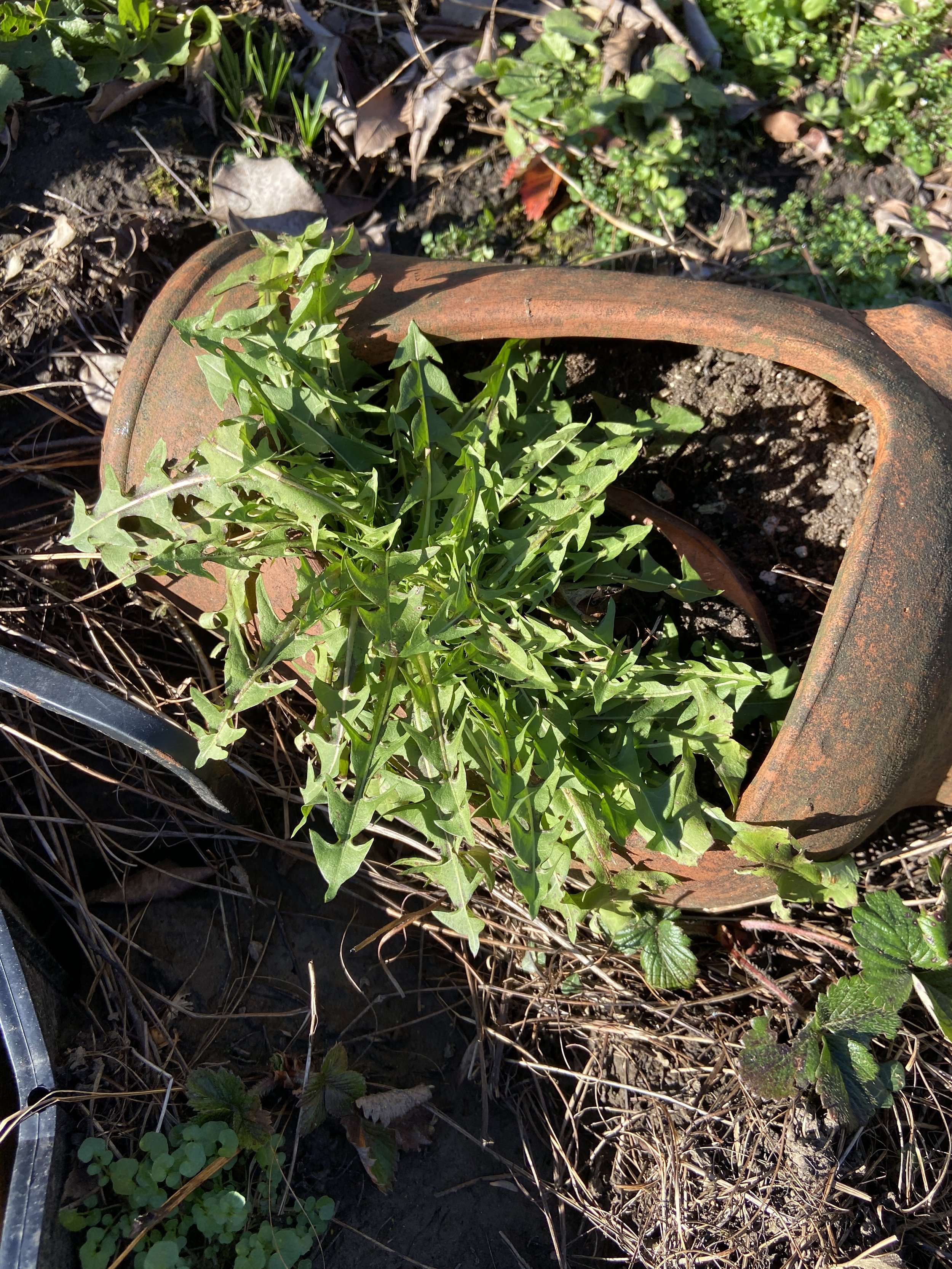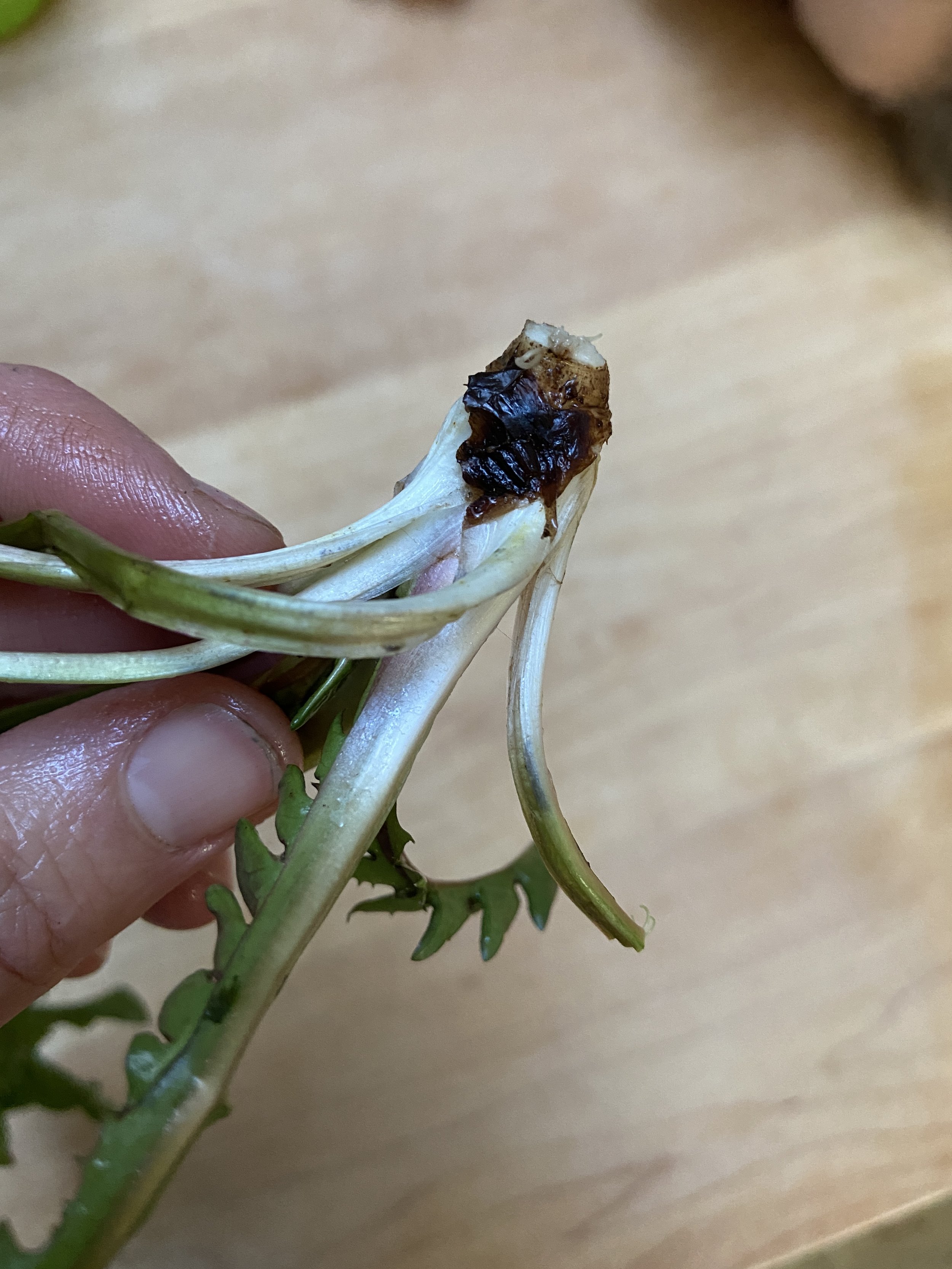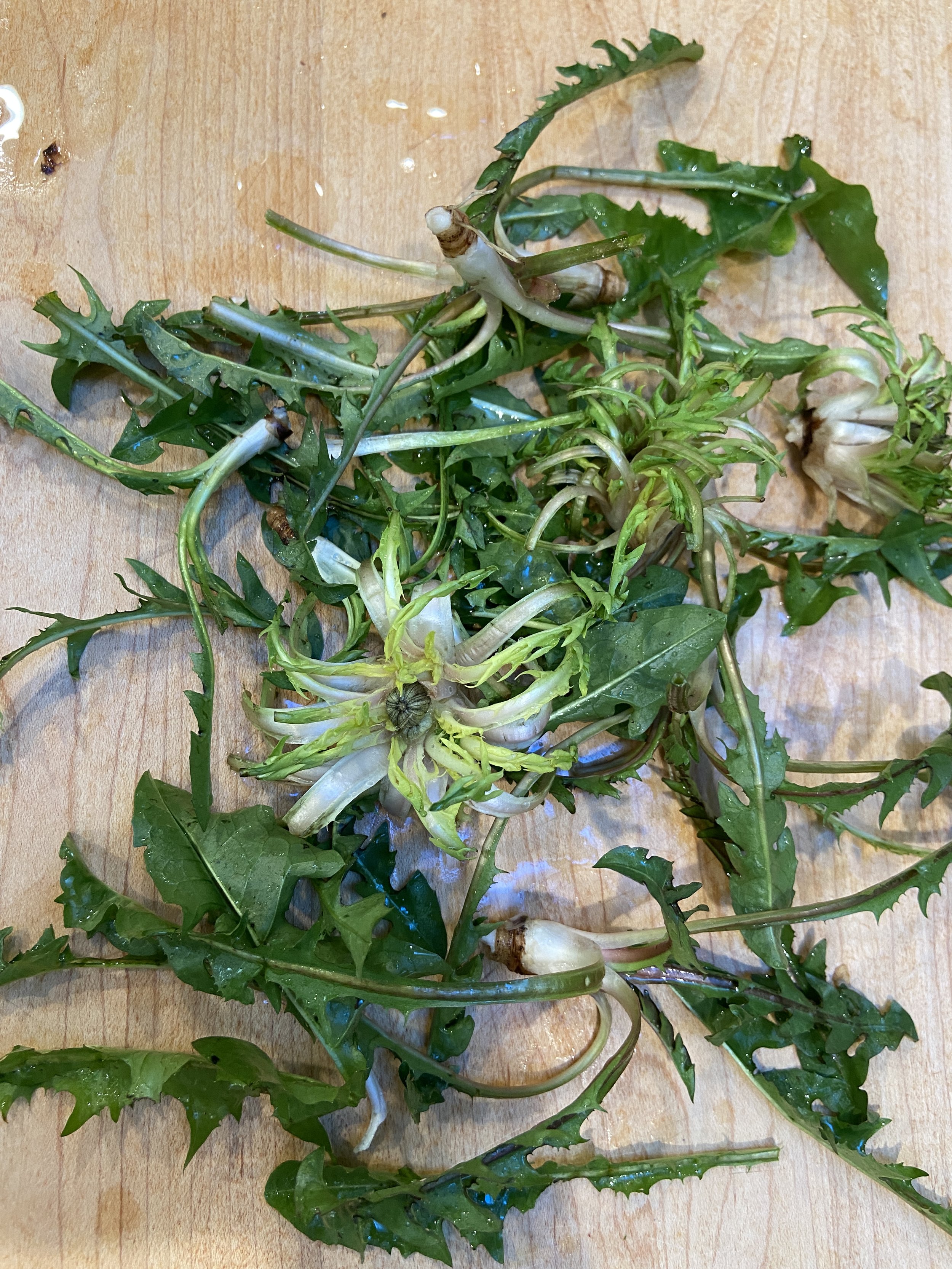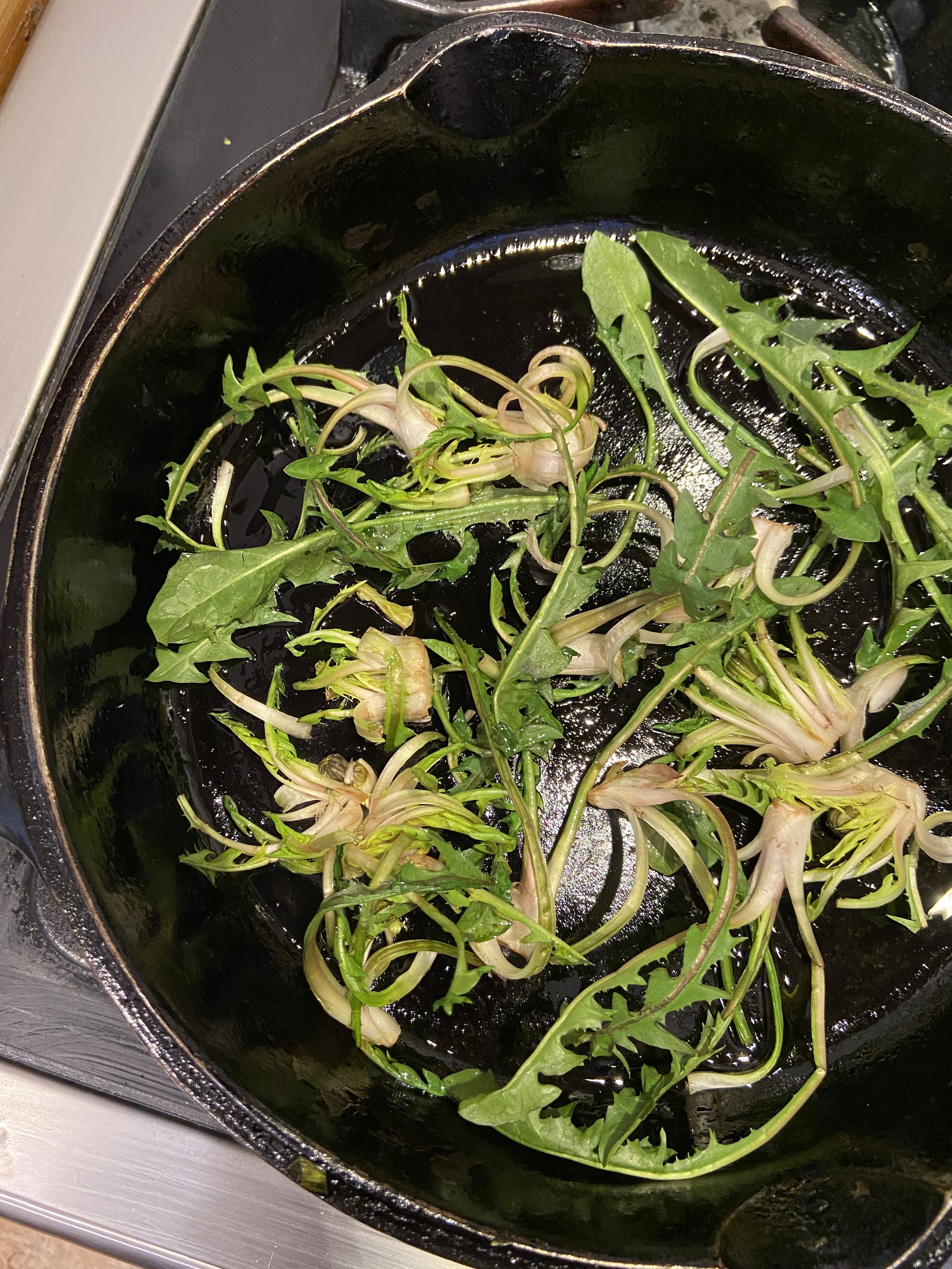Seared Dandelion Hearts
Dandelion hearts (aka dandelion crowns) are even more under-appreciated than dandelion greens, but they are really incredible - kind of like eating an artichoke heart vs. the artichoke leaves. They have the best texture and more mild/less bitter flavor when harvested in the early spring/late winter (or from young plants). It does take a bit of digging to unearth them, but they’re worth it! Because they have similar properties as something like chicory or raddichio, I think they are most delicious seared or wilted with a salty umami dressing with citrus zest. This recipe calls for anchovy, but it can easily be substituted with miso. Would pair beautifully atop polenta or in pasta/ramen noodles!
To harvest: Dig out the dandelion so that you remove the entire base or “heart”. You can also dig up the roots at this point if you want to use them or if you’re in a situation where you’re also weeding a garden and don’t want the dandelion to grow back. Unlike some other foraged wild ingredients, dandelion doesn’t not need to be rationed:) I keep meaning to make dandelion bitters, so maybe I finally will(?)
Ingredients:
6-8 dandelion hearts + tops (you can save the tops for something else if you want)
3 anchovies or 1 tablespoon miso
Juice from 1 lemon or 1-2 tablespoons red wine vinegar
2-3 tablespoons olive oil, separated
Citrus zest - I used orange this time
Black pepper (optional)
Clean dandelion hearts well - I soaked in water a few times and checked between the crevices to make sure dirt was removed.
Chop anchovies and mix with lemon juice using a fork until it creates a paste (a few chunks of anchovy is a-okay). I like to do this in a jar so I can shake it with the olive oil.
Add 1 tablespoon olive oil, mix/shake in jar, and set aside.
Drizzle olive oil in pan (I like to use cast iron for browning) on medium-high. Once hot, add dandelion crowns. Toss for a few minutes, tossing occasionally, until softened and slightly browned. Toward the end, add the dandelion greens and dressing (shake dressing first if it has separated). Toss and remove from heat onto plate.
Top with Citrus zest and black pepper. Add another drizzle of olive oil if needed.
Voila.
Fried Mussels with Wild Greens
Armageddon shmarmageddon - I've got my mussels.

The primary ingredients to this dish are foraged (Baker Beach for mussels and Temescal for greens), so as long as I can rustle up the other ingredients and a burner, I’ll be sitting pretty post-apocalypse. The wild mussels were foragedand thus, quite “rustic” making it virtually impossible to clean them thoroughly and necessitating cooking and taking them out of the shell before consuming, so I decided to fry them. The below recipe serves 3-4 as an appetizer.

1 pound fresh mussels, rinsed and scrubbed as best you can
1 cup cornmeal, medium grind
1/2 teaspoon paprika
1 egg, beaten
1/2 teaspoon salt
2 tablespoons high heat oil, such as grapeseed or coconut
1 lemon wedge (can use a slice from dressing, below)
Foraged greens, such as dandelion and sow thistle tossed with lemon-olive oil dressing (Combination of juice from 1/2 lemon, 1 tablespoon olive oil, and 1/2 teaspoon of mustard for 1 cup greens) - I like a lot of greens, but whatever is best for your preference of fried mussel:green ratio

Boil mussels in a large pot of water (rolling boil) for about 7 minutes, or until mussels open. remove mussels from shell, drain any excess water, and set aside. Discard any mussels that do not open.
Meanwhile, mix cornmeal with paprika and salt on a plate. Dip mussels in beaten egg a few at a time, then toss in cornmeal mixture to coat.
Heat oil on medium-high. Once oil is hot, add mussels and brown on each side, about 3-5 minutes total. Remove from oil, place atop wild greens tossed with dressing, drizzle with squeeze of lemon, and sprinkle with paprika.
Serve with aioli, if desired.
Shaved Zucchini Salad With Parmesan and Toasted Pine Nuts
I never appreciated raw zucchini until I tried this salad. It was 2008 in Italy at the Terra Madre conference where I was fortunate enough to attend as a delegate. Before that fortuitous encounter, I believe undercooked zucchini to be a missed opportunity relegated to steam tables at low-budget buffets alongside poorly done chicken parmesan. However, slicing zucchini squash into delicate slivers, tossing with a fresh lemon-olive oil dressing, and pairing with toasted pine nuts and parmesan (as is done in this salad) totally transforms the texture and flavor to be something purely delightful. The other great thing about this salad? It's incredibly quick to make, requires ingredients you are likely to already have around, and is the perfect addition to a summer dinner washed down with rose. Below recipe serves 4, but can easily be adapted to more or less people.
2 large zucchini (or summer squash)
Juice from 1/2 lemon
2 tablespoons olive oil
Salt and black pepper to taste
1 ounce pine nuts
1 ounce parmesan
2 tablespoons chopped fresh parsley
Using a mandolin, shave zucchini into thin rounds or thing long slices*.
Whisk lemon juice, olive oil, and a few pinches of salt and pepper. Toss zucchini in dressing and add more salt/pepper to taste.
Toast pine nuts in a cast iron pan on medium high for about 2 minutes, tossing frequently, until golden brown.
Top zucchini with pine nuts, grated parmesan, and parsley.
Serve at room temperature.

Delicate rings of raw zucchini to eat by the forkful.
Couscous Salad with Edamame, Feta, and Mint
This bright salad will make sure you know that spring has sprung. It's very fast to prepare and ideal for picnic-type gatherings. You'll be surprised how many people ask you for the recipe!
1 cup dry whole wheat couscous
Juice of 2 medium lemons
1/4 cup olive oil
1/4 cup white wine or rice vinegar
1/2 teaspoon salt
2 tablespoons lemon zest (use lemons above)
2 cups (10 ounces) fresh or frozen shelled edamame beans
1/2 cup finely diced mint
3/4 cup crumbled feta cheese
Bring 1 cup of water to boil and then remove from heat. Stir in dry couscous and cover with a lid. Allow to sit for 7 minutes, then remove lid and fluff couscous with a fork.
Whisk together lemon juice, olive oil, vinegar, and salt. Remember to zest lemon first for the next step.
Once couscous has cooled to room temperature, toss in zest, edamame, mint, feta, and dressing.
Serve cold or at room temperature.

fennel, bulgur, & chicken salad with blood orange
A bright future for leftovers.
One of the most satisfying things to do in the kitchen is to reinvent leftovers and salads are a great way to do this as they allow for the addition of all kinds of bits and pieces. This recipe calls for chicken breast and provides cooking instructions, but there's no reason you couldn't chop up some leftover roast chicken, now is there? Along the same vein - no grapefruit? No problem - try oranges or even apples! Out of bulgur, but have some quinoa? Sounds great! Really - the possibilities are endless, but I really do enjoy this combination of the sweetly herbal, crunchy fennel and the juicy, rich blood orange paired with chicken and bulgur. Fantastic for lunches or picnics. Serves 4 as a main.

1 cup dry bulgur
Two 6-ounce boneless chicken breasts (preferably skinless)
2 tablespoons grapeseed oil, divided
1/8 teaspoon sea salt, divided
3 medium blood oranges
Juice from 1 lemon
1 large fennel bulb, with fronds (try wild fennel stalks and fronds!)
1/4 cup diced fresh green onion
Salad greens (optional)
Preheat the oven to 500 degrees F.
In a saucepan, combine bulgur with 1 cup water and bring to a boil. Cover, reduce heat, and simmer for 10-12 minutes, or until tender. Set aside to cool.
Meanwhile, coat the chicken breasts with 1/2 tablespoon of grapeseed oil and sprinkle with about half of the salt. Lay the chicken on a baking sheet and bake on the top oven rack for 15 minutes or until cooked through - flip the chicken halfway through cooking time. Allow to cool and then slice into 1/4-inch thick strips.
Cut oranges in half. Squeeze the juice from one of the halves into a small bowl or jar. Add the remaining grapeseed oil, salt, tablespoon of olive oil, and lemon juice to the blood orange juice. Whisk or cover jar and shake until thoroughly combined.
With a knife, remove the peel and outside pith of the remaining 5 orange halves. Slice into wedges. It's helpful to know how to segment citrus like a boss.
Remove the fronds from the fennel bulb and thinly slice the bulb. Chop several of the fronds, enough to fill 1/2 cup.
Toss bulgur with dressing, chicken, orange wedges, fennel bulb, fennel fronds, and green onion. Serve at room temperature or cold atop salad greens (if desired).
Preheat the oven to 500 degrees F.
In a saucepan, combine bulgur with 1 cup water and bring to a boil. Cover, reduce heat, and simmer for 10-12 minutes, or until tender. Set aside to cool.
Meanwhile, coat the chicken breasts with 1/2 tablespoon of grapeseed oil and sprinkle with about half of the salt. Lay the chicken on a baking sheet and bake on the top oven rack for 15 minutes or until cooked through - flip the chicken halfway through cooking time. Allow to cool and then slice into 1/4-inch thick strips.
Cut oranges in half. Squeeze the juice from one of the halves into a small bowl or jar. Add the remaining grapeseed oil, salt, tablespoon of olive oil, and lemon juice to the blood orange juice. Whisk or cover jar and shake until thoroughly combined.
With a knife, remove the peel and outside pith of the remaining 5 orange halves. Slice into wedges. It's helpful to know how to segment citrus like a boss.
Remove the fronds from the fennel bulb and thinly slice the bulb. Chop several of the fronds, enough to fill 1/2 cup.
Toss bulgur with dressing, chicken, orange wedges, fennel bulb, fennel fronds, and green onion. Serve at room temperature or cold atop salad greens (if desired).
Segment Citrus "Like a Boss"
A mature approach to citrus in salads.
Update: I just found out when I made an olive oil cornmeal cake with blood orange that this technique has a name - supreming. Who knew!
A good salad in a restaurant will have something that's lacking in a salad made at home. This something is love - enough love for a salad that you'll put in a little effort. Now, I'm not naming any names, but I'm sure we've all been there - salad as an afterthought. Of course, there's always room for a simple green salad with any meal, but sometimes you want to "get a little fancy".
One trick for doing so that I picked up while working at restaurants is segmenting citrus like a boss. By using this simple technique, your citrus segments reveal only flesh, rather than the surrounding pith and are colorful, shiny, and juicy. Here's what you do:

Cut peel off of citrus fruit.
Cut away the peel from the citrus fruit by slicing off each end and cutting down the edge of the fruit to reveal the flesh.
Cut out segments from pith around edge of the fruit.
As you get toward the end, it can be difficult to segment them perfectly, but don't worry, you can slice through the pith at this point. I also like to squeeze the juice from the edges and remaining pith into the salad dressing.


Cut into flesh to remove segments.

Removing beautiful segment.
Moroccan "Chick-Chick" Salad
Chick peas and chickweed unite.

This salad is a fun play on "chickweed" and "chickpeas" blended together with the Moroccan flavors of pomegranate, cumin, and possibly feta.
My list of favorite foraged greens is long, but chickweed *might* be in the top 5. If not the top 5, then definitely the top 10. Lucky for me, it is one of the most abundant "weeds" available and is also drought resistant - armageddon? Sign me up!
In the Bay Area, you'll find chickweed in abundance after rains when the sun inevitably returns and all the greens start poking up. What I love about this wild green is how soft and delicate the greens are, both in flavor and texture, while still having a slight crunch and very fresh flavor.
To identify chickweed, look for a sprawling plant with oval pointed leaves and possibly small white star-shaped flowers. The most obvious identifying characteristics are:
It does not have milky sap
It has one line of hairs on the side of the stem
If you pull gently on the outer part of the stem, it will separate and there will be a thin inner part that does not separate (try a few times, it might take a bit to get the hang of it)
Some recipes call for cooking chickweed, but I think it's best raw or, maybe, slightly wilted over a soup or by the hot chickpeas in this salad. Serves 2.

3/4 cup cooked chick peas
1 tablespoon plus 2 teaspoons olive oil, divided
1/2 teaspoon cumin
Sea salt
1 tablespoon lemon juice
1 teaspoon pomegranate molasses
4 cups chickweed, washed and dried
1-2 ounces crumbled feta (optional)
Heat cast iron with about 2 teaspoons of olive oil on high. When cast iron is hot, add the chickpeas. Cook, stirring periodically, until beans are lightly browned, about 5 minutes. Once cooked, place in bowl and toss with cumin and a few pinches of sea salt.
“The term “chickweed” is based on the fact that chickens love it —- cute!”
Add lemon juice, pomegranate molasses, remaining olive oil, and a pinch of salt to a mason jar. Whisk with a fork or cover jar and shake to combine.
Combine chickpeas with chickweed in a bowl, drizzle with dressing, and top with crumbled feta (if desired). Serve immediately.

Moroccan chick-chick salad with optional feta.





















